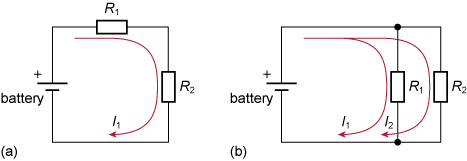Series and parallel networks (combining the laws)
The ordering of the components, and how they are connected, is important in a circuit. For example, two components (here resistors) can be arranged in two different ways, as shown in Figure 11. A circuit in which the current must take a single path, going through first one component and then the other in series, is shown in Figure 11(a); a circuit in which the current splits and takes two parallel paths at the same time is shown in Figure 11(b).
By combining Ohm’s and Kirchhoff’s laws, it can be shown that:
the total resistance of resistors in series is given by
the total resistance of resistors in parallel is given by
SAQ 2
In Figure 11, let and . To three significant figures:
- a.What is their resistance in series?
- b.What is their resistance in parallel?
Answer
- a.In series, the combined resistance is.
b.In parallel, the combined resistance is
to three significant figures.
Alternatively, note that for two resistors in parallel,
so the resistance in parallel can be written simply as

